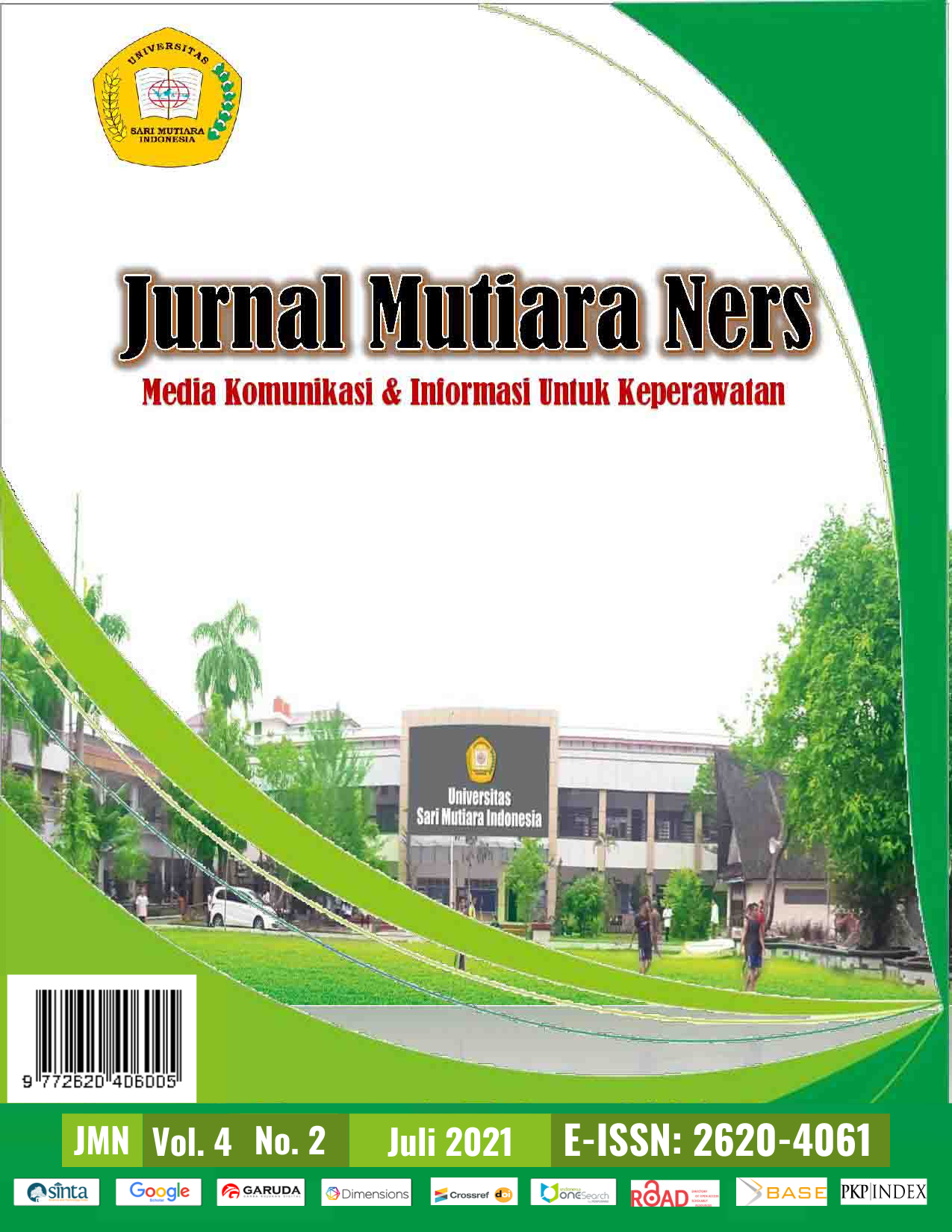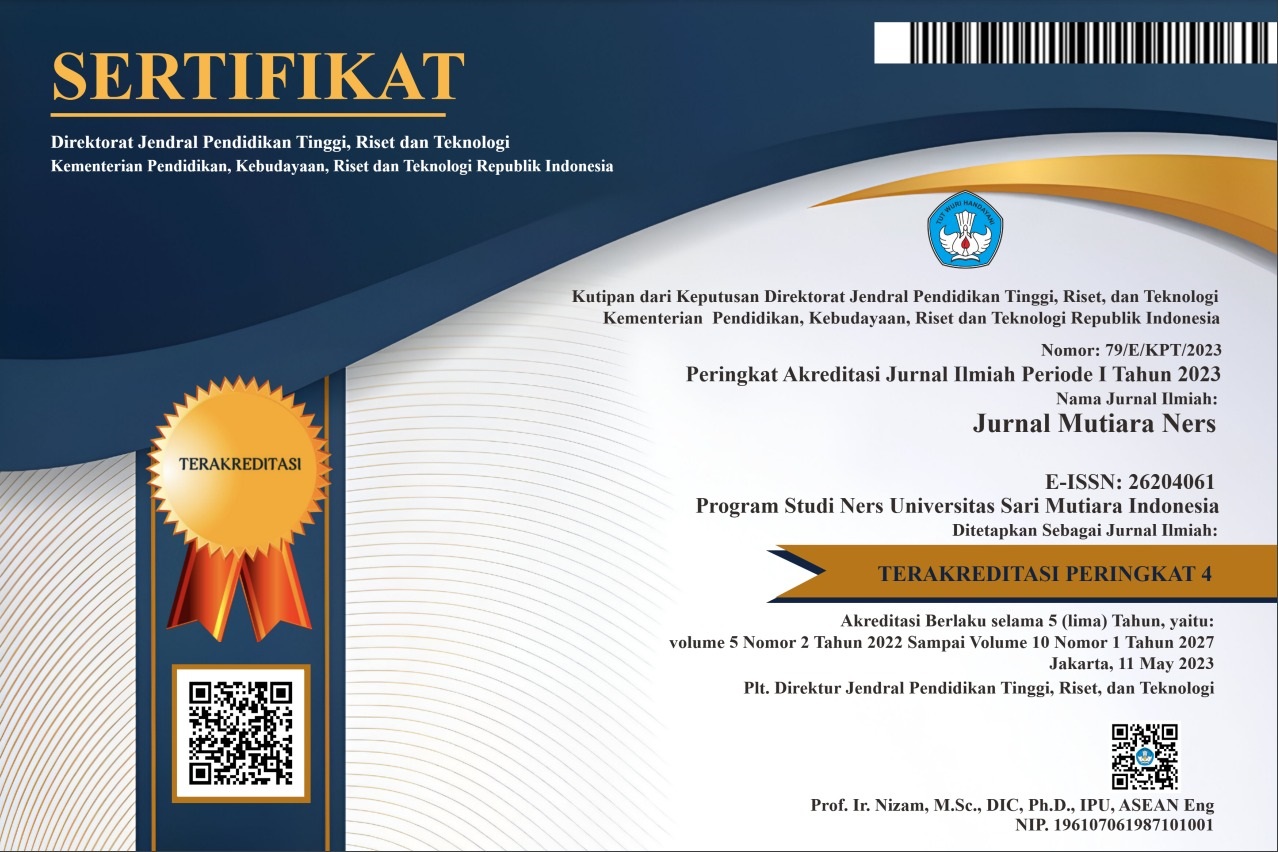HUBUNGAN KARAKTERISTIK IBU HAMIL DENGAN KLASIFIKASI PRE EKLAMSIA DI BEKASI
Keywords:
Characteristics, Pre-Eclampsia, ClassificationAbstract
Pre-eclampsia is a collection of symptoms such as hypertension, edema and proteinuria in pregnant, childbirth and postpartum women that occur at 20 weeks of gestation until the end of the first week after delivery. Pre-eclampsia can adversely affect the mother and fetus, such as fetal distress and even death due to lack of oxygenation. Maternal mortality rate (MMR) which occurs where one of the causes is pre-eclampsia. This study aims to determine the relationship between the characteristics of pregnant women (maternal age, parity, education, occupation and history of hypertension) to the classification of pre-eclampsia. Quantitative descriptive research design, with a total sampling of 73 pregnant women patient respondents at the East Bekasi Private Hospital in 2018-2019 who experienced pre-eclampsia. It was found that the results of the classification of respondents were mostly mild pre-eclampsia. The analysis used chi square with the conclusion that there is a relationship between the age of pregnant women and the classification of pre-eclampsia (P value 0.000), parity (P value 0.023), history of hypertension (P value 0.000). There is no relationship between education (P value 0.667) and work (P value 0.624). This research is expected to be a reference in order to improve service to patients, especially in conducting assessments on pregnant women. Where maternal age, parity and history of hypertension have a relationship with the classification of preeclmasia in pregnant women.
Downloads
References
Ahmed, E. M., Hassanen, R. H., Abbas, A. M., & Kalaf, S. A. (2018). Predict Risk Factors of Preeclampsia Among Pregnant Women Attended Antenatal Clinic at Assiut University Hospital. Assiut Scientific Nursing Journal, 6(14), 145-156.
Bobak, Lowdermilk. (2012). KeperawatanMaternitas. Jakarta: EGC
Departemen Kesehatan RI. Laporan Hasil Riset Kesehatan Dasar (RISKESDAS) Indonesia Tahun 2007. Jakarta; Departemen Kesehatan RI ; 2008
Fatkhiyah N., Kodiyah, Masturoh. (2015). Determinan maternal kejadian preeklamsia. Jurnal Keperawatan Soedirman, Volume 11, No.1, Maret 2016
Harun, Ayatullah.,dkk. (2019). Faktor yang Berhubungan Terhadap Kejadian Preeklamsia di RSUD Syekh Yusuf Gowa Tahun 2019. Vol 3, No 1, September 2019, p-ISSN: 2597-7989, e-ISSN: 2684-8821.
Iqomatulhaq, Ermiati, Solehati Tetti. (2018). Healthy Life Behavior in Pregnancy Women with Risk of Preeclampsia in The PHC of Cigraviday Bandung District. JMCRH: Vol. 2 Issue 1
Khuzaiyah, S., Anies, A., & Wahyuni, S. (2016). Karakteristik Ibu Hamil Preeklampsia. Jurnal miah kesehatan, 9(2), 97065.
Kurniawati, D., Septiyono, E. A., Juliningrum, P. P., & Rahmawati, I. (2019). Analysis Characteristics of Pregnant Mother With Preeclampsia in Agronursing Area. Journal Of Nursing Practice, 3(1), 33-38..
Leveno, Kenneth. (2015). Manual komplikasi kehamilan Williams. Jakarta:EGC
Machmudah. (2015). Penerapan Model Konsep Need For Help dan Self Care pada Asuhan Jeperawatan Ibu Pre Eklamsia Berat dengan Terminasi Kehamilan. Jurnal Keperawatan Maternitas. Vol 3, No.1, Mei 2015; 16-26
Novianti, H. (2016). Pengaruh Usia dan Paritas terhadap Kejadian Pre Eklampsia di RSUD Sidoarjo. Journal of Health Sciences, 9(1).
Pratamaningtyas,Susanti., Niluh Novita. (2016). Hubungan Obesitas Dengan Klasifikasi Preeklamsia Di Puskesmas Ngasem Kabupaten Kediri Tahun 2016. Jurnal Kesehatan Ibu dan Anak vol. 3 No. 2, Pebruari 2018:12 - 21.
Purde, M. T., Baumann, M. U., Wiedemann, U., Nydegger, U. E., Risch, L., Surbek, D., & Risch, M. (2015). Incidence of preeclampsia in pregnant Swiss women. Swiss medical weekly, 145(w14175), w14175.
Putriana, Y., & Yenie, H. (2019). Faktor-Faktor yang Berhubungan dengan Kejadian Pre Eklamsia pada Sebuah Rumah Sakit di Provinsi Lampung. Jurnal Ilmiah Keperawatan Sai Betik, 15(1), 31-42..
Ramie, A., & Fahreza, F. (2018). Riwayat Keluarga Preeklampsia Meningkatkan Kejadian Preeklampsia. Jurnal Citra Keperawatan, 6(2), 35-51.
Rohani, S., Wahyuni, R., & Veronica, S. Y. (2019). Faktor–Faktor yang Berhubungan dengan Kejadian Pre Eklamsia Berat di Rumah Sakit Umum Pringsewu. Wellness And Healthy Magazine, 1(1), 77-85.
Rumjati, Sri Wahyuni. (2012). Gambaran tingkat pendidikandan Usia Ibu Hamil Dengan Pengetahuan Tentang Bahaya Preeklamsia Berat. Jurnal Kesehatan Abdurahman palembang, Vol.1 No.1 Maret 2012.
Sabar, E., Setyawati, A., & Emaliyawati, E. (2018). Foot Massage Modification to Reduce Blood Pressure in Pregnant Woman with Preeclampsia.Jurnal Keperawatan Padjadjaran,6(2).
Sirait, Anna Maria. (2012). Prevalensi Hipertensi Pada Kehamilan di Indonesia dan Berbagai Faktor yang Berhubungan dengan (Riset Kesehatan Dasar 2007).
Sukarni, I.K danWahyu.(2013). Buku Ajar Keperawatan Maternitas. Yogyakarta:NuhaMedika
Tessema, G. A., Tekeste, A., & Ayele, T. A. (2015). Preeclampsia and associated factors among pregnant women attending antenatal care in Dessie referral hospital, Northeast Ethiopia: a hospital-based study. BMC pregnancy and childbirth, 15(1), 1-7.
Tolinggi, S., Mantualangi, K., & Nuryani, N. (2018). Kejadian Preeklampsia dan Faktor Risiko yang mempengaruhinya. Gorontalo Journal of Public Health, 1(2), 85-91.
Wawan, A dan M. Dewi. (2016). Pengetahuan, Sikap dan Perilaku Manusia. Yogyakarta: Nuha Medika
Wiknjosastro. (2010). Buku Panduan Praktis Pelayanan Kesehatan Maternal Dan Neonatal.Edisi 1 Cet.12 Jakarta: BinaPusaka
Yuniarti, Siswari. (2019). Faktor Yang Berhubungan Dengan Kejadian Preeklamsia Di Rumah Sakit Umum Haji Surabaya. Semnakes.unipa.ac.idISBN: 978-602-5793-65-3.
World Health Organization. (2014). Maternal and Reproductive Health. WHO Press: Genewa


.png)





